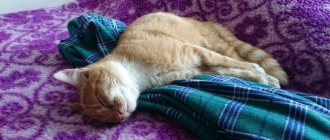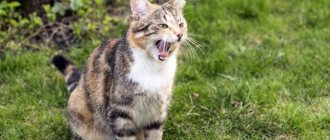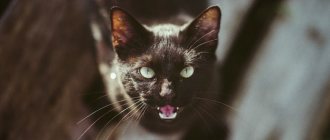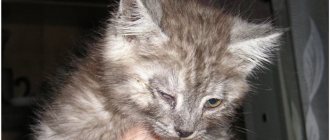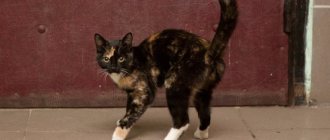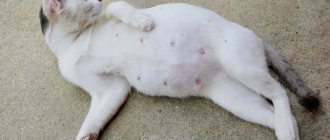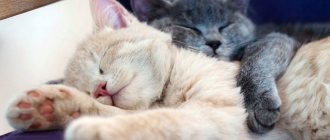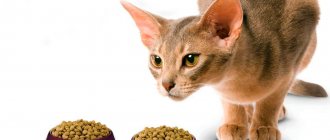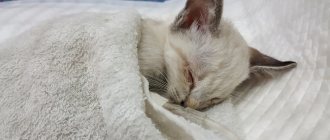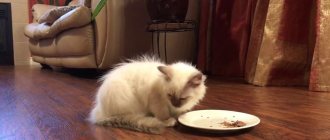A pet’s reluctance to eat can be associated with pathological and physiological factors. Appetite stimulants for cats are selected by a veterinarian depending on the reasons that provoked the problem. A kitten's lack of desire to eat food may be due to an inappropriate bowl or the pet does not like the food itself. Also, the cause of poor appetite often lies in the influence of stress. Such factors can be easily eliminated and the pet will start eating again. But if the disorder is due to illness, then the cat will additionally experience vomiting, lethargy, fever, and other unpleasant symptoms that cannot be eliminated without the help of a specialist.
Why is there a problem?
Physiological reasons
Often a cat’s poor appetite is associated with dirty dishes or the selection of a low-quality bowl for eating food. There are other natural factors that lead to a cat’s reluctance to consume food:
- Increased air temperature. Loss of appetite often occurs in the summer during hot weather. In this case, it is important to provide your pet with constant access to clean, drinking water.
- Sudden changes in the cat's diet.
- Change of feeding place. If the owners constantly rearrange the cat's bowl, then the cat may lose its appetite completely or partially. To fix the problem, simply return the cat's plate to its place.
- Impact of stress.
- Aging of the body. With age-related changes, the pet becomes lethargic, moves less and there is a decrease in appetite.
- Hair accumulation. Cats are clean animals and love to lick themselves constantly, which is why a lot of hair collects in the stomach. In this case, the cat’s lack of appetite can also cause vomiting and problems with stool.
Veterinarians note that during puberty, an animal may lose its appetite for several days, and sometimes even a week. At the same time, owners should not worry, since the disorder will go away on its own after estrus.
Pathological factors
In animals, this symptom may appear in diabetes.
If the cat has lost its appetite and has lost a lot of weight, this may indicate the development of the disease. The following pathologies are identified that influence the reluctance to eat food:
- infection with small parasites;
- diabetes;
- heart diseases;
- kidney failure;
- intestinal obstruction;
- inflamed upper respiratory tract and paranasal sinuses;
- anemia;
- diseases associated with tooth decay;
- inflammation of the pancreas;
- leukemia;
- inflammatory reaction in the intestines;
- pills and other drugs that negatively affect the cat’s appetite.
How does chronic renal failure develop in cats?
Chronic renal failure is a constantly progressive irreversible disease.
Its cunning lies in its long, completely asymptomatic course.
It slowly and mercilessly destroys the kidneys until less than 45% of the kidney tissue remains.
Chronic renal failure has three stages:
- Initial – there is a decrease in appetite, dry skin, and periodic vomiting. The creatinine level at the initial stage does not exceed 250 µmol/l.
- Conservative - the animal is depressed, attacks of diarrhea and vomiting are possible, the eyes are sunken, the withers, when compressed, do not straighten out (the first sign that the animal’s body is severely dehydrated). Creatinine ranges from 260 to 440 µmol/l.
- Terminal – the level of creatinine in the blood exceeds 440 µmol/l. The cat may develop seizures, uremic encephalopathy, and interstitial pulmonary edema.
It is important to understand that CKD (chronic kidney disease) is an incurable disease. However, modern veterinary medicine is able to stabilize the animal’s condition and provide high-quality supportive therapy, which significantly increases the life of cats.
Additional symptoms
If your pet refuses to eat and has lost a lot of weight, this may indicate a serious illness. In this case, stimulating appetite will be useless if the owners do not cure the underlying disease. If there is pathology in a pet, the following alarming signs are observed:
Against the backdrop of the developing disease, the pet looks lethargic.
- lethargy and apathy;
- bloating;
- changes in the structure and color of the coat;
- impaired stool, in which diarrhea may be replaced by constipation;
- unpleasant odor from the mouth;
- itching sensations in the anus;
- impurities in urine and feces, blood and/or mucus;
- thin skin and possible bluish discoloration;
- gagging;
- rapid heartbeat;
- pain in the abdominal area;
- rapid breathing.
Esophagostomy
An esophagostomy should be considered whenever the patient either has anorexia or is unable to eat for any reason (eg, severe maxillofacial trauma, neoplasm). Esophagostomy tubes are easy to place, require minimal equipment, and can be used immediately. Esophagostomy is contraindicated in patients who are unable to protect their airway, those with vomiting or regurgitation, or those with functional or mechanical esophageal abnormalities such as megaesophagus or stricture (3). Placing an esophagostomy requires anesthesia, but usually not as deep as that used for surgical interventions. The patient must be sufficiently anesthetized to place the speculum in the mouth without being able to bite.
Depending on the method used and the size of the patient, an 8–20 Fr catheter is selected. The large diameter of these catheters makes it possible to opt for crushed recovery diets, sometimes even without dilution with water. They are also convenient for owners to provide nutritional support to their pets, as long as vomiting does not occur. For cats with chronic kidney disease, an esophagostomy tube can provide another method of fluid delivery and even replace the uncomfortable, stressful procedure of infusing fluid into the subcutaneous space. Once the stitches are removed, the tube can simply be pulled out. It is recommended to treat the exit hole as a wound that heals by secondary intention. You can also apply a simple bandage in the first 12 hours after the stitches are removed. Complications associated with esophagostomy tube placement include dislodgement of the tube due to vomiting or removal by the patient, cellulitis around the introitus, and biting off the end of the tube by the patient after vomiting (1).
Gastrostomy
Gastrostomy tubes are used for long-term nutritional support in seriously ill animals. Gastrostomy tubes can fairly easily provide formula to chronically ill or anorexic patients over many weeks or months (6). The gastrostomy tube delivers nutrition distal to the esophagus, making enteral nutrition possible in patients with esophageal diseases. Gastrostomy is well tolerated, allows bolus feeding, and is intended for long-term feeding at home (2). The gastrostomy allows the patient to eat normally and helps transition the animal to normal feeding before its removal. Gastrostomy placement can be performed surgically or percutaneously. Percutaneous gastrostomy can be placed with or without an endoscope (5). Major complications associated with gastrostomy include injury to the visceral peritoneum during percutaneous placement and peritonitis due to gastric contents entering the peritoneal cavity due to dislodgement or exposure of the tube. As with any surgically placed feeding device, cellulitis and infection at the insertion site are possible (2).
Jejunostomy
Small diameter probes can be placed directly into the proximal jejunum. Feeding distal to the pylorus makes enteral nutrition possible for animals unable to tolerate feed through the stomach. Indications for jejunostomy placement include gastroparesis, uncontrolled vomiting, pancreatitis in dogs, and failure to protect the airway. The most common method of jejunostomy placement is surgical via laparotomy, although transpyloric placement of nasojejunal and gastrojejunal tubes has been described. Jejunostomies are used for a relatively short period (days to weeks) (2). Feeding should be continuous feeding (CI). Bolus administration of formula may cause cramping and diarrhea (5). Complications associated with jejunostomy include peristomal cellulitis or infection, peritonitis secondary to stoma leakage, retrograde tube migration, bowel obstruction due to tube migration, and tube occlusion (2).
Ways to improve appetite
Changing your daily diet
To prevent your cat from losing the desire to eat, you must always feed him high-quality and healthy food. Since representatives of the cat family are carnivores, milk alone is not enough for its stomach to function normally. It is possible to increase your cat's appetite by giving him meat, poultry and other healthy foods. If your pet has sensitive digestion, it is recommended that you, together with a specialist, select a special food and feed it only. It is important to understand that it is not possible to improve the appetite of cats with the following dishes:
Sweet treats will not solve the problem.
- table scraps;
- soups and fatty broths;
- salty food;
- sweets.
To stimulate the digestive tract, veterinarians recommend giving your cat a raw yolk once a week.
To improve appetite, it is recommended to feed your pet meat and fish, and grains and herbs in moderation are also beneficial for the cat’s body. It is possible to increase your cat's appetite if you give him a small amount of catnip. Such a stimulant can be addictive in a pet, so it is worth consuming a little of it, just a few leaves, after which the functioning of the digestive tract improves.
What vitamins will help?
Decreased or increased appetite in a cat can be observed both against the background of pathological and physiological factors. To normalize digestion, the animal needs to be given vitamins and special nutritional supplements. Special complexes are suitable for the cat's body, helping to awaken appetite, which contain seaweed, mint, yeast and other useful components. Thanks to such vitamins and supplements, the cat's metabolic processes improve.
The grown grass will have a positive effect on the general condition of the animal.
If the cat has lost his appetite, then to make it appear again, it is recommended to grow grass at home, which is a good stimulant. With its help, your pet not only returns the desire to eat, but also strengthens the immune system. You can purchase sprouted grass at a pet store or grow it yourself at home.
Medicines that help with the problem
Medicines help awaken an animal’s appetite, but it is important to understand that any tablet should not be given to a cat without a veterinarian’s prescription, since the risks of complications are high. This technique is used only in extreme cases when other methods do not give a positive result. Veterinarians recommend the following medications to increase appetite:
- "Periatin". The drug primarily stops the allergic reaction. You can purchase the drug at a veterinary pharmacy, and it is available in the form of tablets, gel or liquid. The latter products are applied to the fur near the tips of the cat's ears. This is a good stimulant aimed at increasing appetite.
- "Remeron". The drug is prescribed to people with depression, but it is also possible, as prescribed by a veterinarian, to be given to cats to increase the desire to eat. With its help, it is possible to reduce the manifestation of nausea.
- "Valium." If the cat has no appetite, then it is possible to use this medicine. The dosage is selected exclusively by a specialist and it is strictly forbidden to give the medicine at your own discretion.
Tip 4: Catnip and cats
A long time ago it was noticed that cats love valerian and catnip, which act on them like a drug. Cats may behave differently after smelling catnip, but the behavior will most likely be strange. How does catnip affect cats?
The Nepeta cataria plant, popularly called catnip, contains a substance called nepetalactone that attracts cats. Kittens no older than 2 months are, however, indifferent to this plant.
Cats, as usual, sniff the catnip leaves, lick or chew them, and then behave in an unusual way. Moreover, this behavior can be different: some cats rub their faces against the plant, others stand with their eyes fixed at one point and shake their heads, and others roll back and forth on the floor. This behavior continues for an average of 5-15 minutes. Repeated sniffing of catnip for an hour does not produce the same reaction.
Nepetalactone is a distant, but still relative of hallucinogens, including marijuana. Therefore, it is absolutely possible that a cat that sniffs catnip experiences a state of euphoria close to that experienced by people who are in a state of drug intoxication. There is another consideration in this regard: it is possible that this substance is similar in composition to one of the chemicals present in the urine of males, which causes females who inhale it to roll on the floor as if during estrus. In this case, nepetalactone must be a really powerful stimulant, one that affects even males.
It may also be that cats, inhaling the smell of catnip, get pleasure due to the increased sensitivity of the scalp; tea, some representatives of the cat family rub their heads against the plant itself and the ground.
Video on the topic
What can't you do?
If a cat does not want to eat, it is not recommended to disturb him, especially touching his tail. At the same time, it is important to pay attention to the pet so that it knows that the owners are nearby and care about it. It is not recommended to allow loud noises and scandals, which can cause additional stress for the pet. Owners should not leave the cat's food and drink bowl in the air, so it should be washed daily with special products. If you do not want to eat, it is prohibited to carry out independent treatment and prescribe various medications without the knowledge of the veterinarian.
What measures can be taken?
Poor appetite, even in a healthy cat, is a cause for concern. When you refuse to eat, the animal’s body stops receiving the necessary vitamins and minerals. This may affect the activities of individual organs and systems.
Some cats can go without food for 1 to 5 days. They arrange a fasting day for themselves. If during this period the pet remains cheerful and active, and this happens once every few months, there is no need to worry. But kittens, pregnant and lactating females need to be provided with adequate nutrition.
If you don't know what to do if your cat has poor appetite, pay attention to the following tips:
- Try changing your diet. Animals may become bored with the food if you use it for a long period.
- Use cat grass. You can buy it in the store or germinate it yourself at home. The herb stimulates the intestines and thereby increases appetite.
- Give your animal vitamins. Pharmacies and pet stores sell special vitamin complexes, but you should consult your veterinarian before purchasing them. Fish oil may be a good alternative. It can be given to both adult pets and kittens.
Advice! During the molting period, be sure to give your cat a special paste that helps remove the fur out. This will prevent its accumulation in the intestines.
Drawing attention to food
This is a fairly simple method that allows you to solve the problem and increase your appetite. You can attract your cat's attention with your favorite treats. This risks the animal being spoiled, but everything is good in moderation. You can offer food as food with a strong, characteristic odor that stimulates appetite.
Tuna or sardines are suitable for this purpose. Research shows that these are the types of fish that elicit the greatest response from cats. A few drops of catnip extract will further enhance this effect. An increase in the content of B vitamins in food has a similar effect. And best of all, create conditions that will awaken hunting instincts. Hang pieces of food on a string so that your pet has to work hard to get them.
Diagnostics in a veterinary clinic
It is difficult to identify immunodeficiency at an early stage due to the polymorphism of symptoms. In addition, conducting tests to detect antibodies to the pathogen is a technically complex, expensive procedure and cannot be carried out in every veterinary clinic.
If immunodeficiency is suspected, the specialist will prescribe tests such as a clinical blood test, enzyme-linked immunosorbent assay, or polymerase chain reaction method. To obtain information, you need not only blood, but also other biological fluids - lymph, saliva.
Research is carried out no earlier than 2.5 months after possible infection. If diagnosis is made earlier, a false negative result is possible.
Kittens from an infected cat are required to be tested. They undergo enzyme immunoassay. It should be taken into account that the colostral immunity obtained with the mother’s colostrum can give false-positive immunity, so the examination is repeated.
